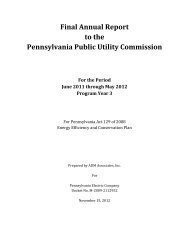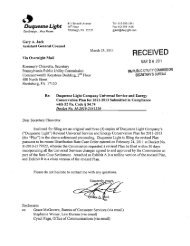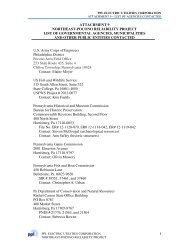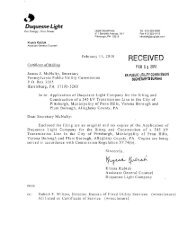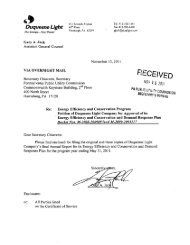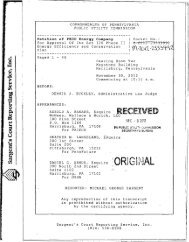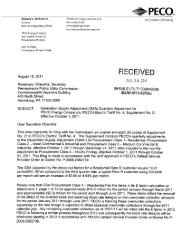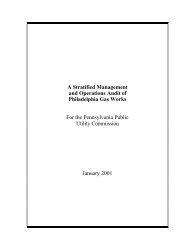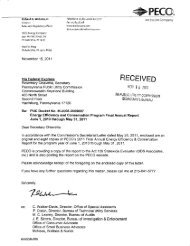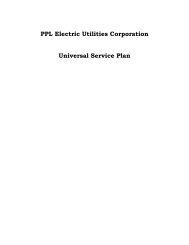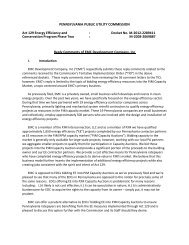Compact Fluorescent Light Bulbs (CFLs)
Compact Fluorescent Light Bulbs (CFLs)
Compact Fluorescent Light Bulbs (CFLs)
Create successful ePaper yourself
Turn your PDF publications into a flip-book with our unique Google optimized e-Paper software.
C o m p a c t F l u o re s c e n t L i g h t B u l b s ( C F L s )<br />
W h a t ’s t h e B i g D e a l ?<br />
Switching from traditional incandescent light bulbs to <strong>CFLs</strong> is an effective, immediate change that<br />
every Pennsylvanian can make to reduce their energy usage and electric bills. <strong>Light</strong>ing accounts for<br />
close to 20 percent of the average home’s electric bill. ENERGY STAR® qualified <strong>CFLs</strong> use 75<br />
percent less electricity and last up to 10 times longer. The Environmental Protection Agency (EPA)<br />
estimates that a CFL will save the user about $30 or more over the life of the bulb. <strong>CFLs</strong> come in<br />
many shapes and sizes and can fit almost any fixture. There are three-way, dimmable, indoor and<br />
outdoor <strong>CFLs</strong> available. See www.energystar.gov for more information on selecting the right light<br />
bulb.<br />
It is important to buy <strong>CFLs</strong> with the ENERGY STAR® logo.<br />
The ENERGY STAR® program is administered by the<br />
EPA and products with its seal of approval are<br />
randomly tested by a third-party to verify that they<br />
meet quality requirements. ENERGY STAR® products are also backed by a<br />
minimum two-year manufacturer warranty.<br />
When choosing a CFL to replace an existing incandescent bulb there are<br />
some important things to consider. First, make sure you read the conversion<br />
information printed on the front of the packaging. That way you will be certain<br />
that your CFL puts out the same amount of light as the old incandescent. For<br />
example, if you want to replace a 60 watt incandescent bulb you would have to<br />
buy a 13- to 15-watt CFL. There are also different bulbs for indoor and outdoor<br />
uses. Finally, since <strong>CFLs</strong> come in different shapes and sizes, it is important to<br />
make simple measurements to ensure that the new bulb will fit in place of the old<br />
incandescent.<br />
W h a t a b o u t M e rc u r y ?<br />
<strong>CFLs</strong> do contain a small amount of mercury that is sealed in the glass tubing –<br />
an average of 5 milligrams. By comparison, older thermometers contain about<br />
500 milligrams of mercury. Currently, mercury is an essential component of<br />
<strong>CFLs</strong> but no mercury is released when the bulbs are intact or in use.<br />
P re c a u t i o n s f o r U s i n g C F L s<br />
<strong>CFLs</strong> are made of glass and can break if dropped or roughly handled. Treat<br />
a CFL with the same care as any glass object. Always screw and unscrew the<br />
bulb by its base (not the glass) and never force the bulb into a socket. If a<br />
CFL breaks in your home, follow the clean-up recommendations on the back of<br />
this sheet.<br />
C F L D i s p o s a l<br />
Because <strong>CFLs</strong> do contain a small amount of mercury, the EPA recommends<br />
recycling the bulbs at your local municipal waste center or go to www.epa.gov/<br />
bulbrecycling or www.earth911.org to identify local recycling options. Home Depot<br />
has also announced that it will be collecting used <strong>CFLs</strong> in all of its stores.<br />
January 2009
C l e a n - U p S u g g e s t i o n s f r o m t h e E P A<br />
1 . B e f o re C l e a n - U p : Ve n t i l a t e t h e R o o m<br />
•Have people and pets leave the room, and don't let anyone walk through the breakage area on their way out.<br />
•Open a window and leave the room for 15 minutes or more.<br />
•Shut off the central forced-air heating/air conditioning system, if you have one.<br />
2 . C l e a n - U p S t e p s f o r H a rd S u r f a c e s<br />
•Carefully scoop up glass fragments and powder using stiff paper or cardboard and place them in a glass jar<br />
with a metal lid (such as a canning jar) or in a sealed plastic bag.<br />
•Use sticky tape, such as duct tape, to pick up any remaining small glass fragments and powder.<br />
•Wipe the area clean with damp paper towels or disposable wet wipes and place them in the glass jar or<br />
plastic bag.<br />
•Do not use a vacuum or broom to clean up the broken bulb on hard surfaces.<br />
3 . C l e a n - U p S t e p s f o r C a r p e t i n g o r R u g<br />
a<br />
•Carefully pick up glass fragments and place them in a glass jar with a metal lid (such as a canning jar) or in<br />
sealed plastic bag.<br />
•Use sticky tape, such as duct tape, to pick up any remaining small glass fragments and powder.<br />
•If vacuuming is needed after all visible materials are removed, vacuum the area where the bulb was broken.<br />
•Remove the vacuum bag (or empty and wipe the canister), and put the bag or vacuum debris in a sealed<br />
plastic bag.<br />
4 . C l e a n - U p S t e p s f o r C l o t h i n g , B e d d i n g , e t c .<br />
•If clothing or bedding materials come in direct contact with broken glass or mercury- containing powder<br />
from inside the bulb that may stick to the fabric, the clothing or bedding should be discarded. Do not wash<br />
such clothing or bedding because mercury fragments in the clothing may contaminate the machine<br />
and/or pollute sewage.<br />
•You can, however, wash clothing or other materials that have been exposed to the mercury<br />
vapor from a broken CFL, such as the clothing you happened to be wearing when you cleaned<br />
up the broken CFL, as long as that clothing has not come into direct contact with the<br />
materials from the broken bulb.<br />
•If shoes come into direct contact with broken glass or mercury-containing powder from the<br />
bulb, wipe them off with damp paper towels or disposable wet wipes. Place the towels<br />
or wipes in a glass jar or plastic bag for disposal.<br />
5 . D i s p o s a l o f C l e a n - U p M a t e r i a l s<br />
•Immediately place all clean-up materials outdoors in a trash container or protected area<br />
for the next normal trash pickup.<br />
•Wash your hands after disposing of the jars or plastic bags containing clean-up materials.<br />
6 . F u t u re C l e a n i n g o f C a r p e t i n g o r R u g : Ve n t i l a t e t h e R o o m D u r i n g a n d<br />
A f t e r Va c u u m i n g<br />
•The next several times you vacuum, shut off the central forced-air heating/air conditioning<br />
system and open a window prior to vacuuming.<br />
•Keep the central heating/air conditioning system shut off and the window open for at least 15<br />
minutes after vacuuming is completed.




